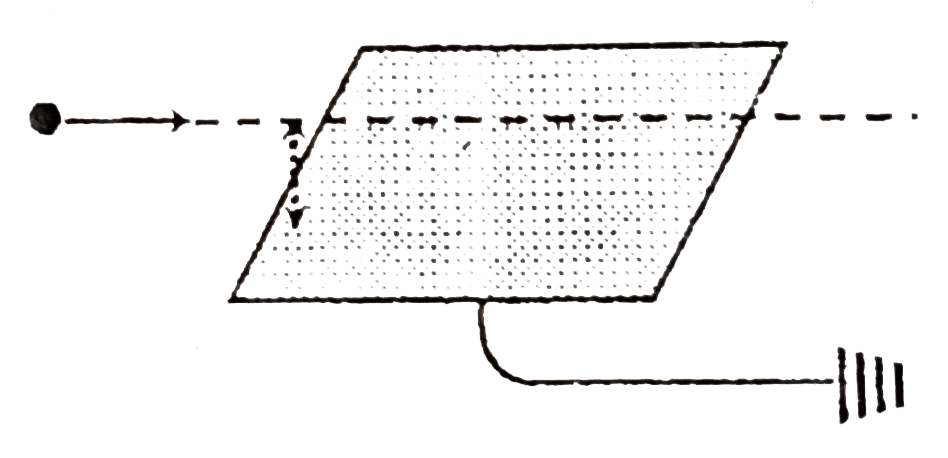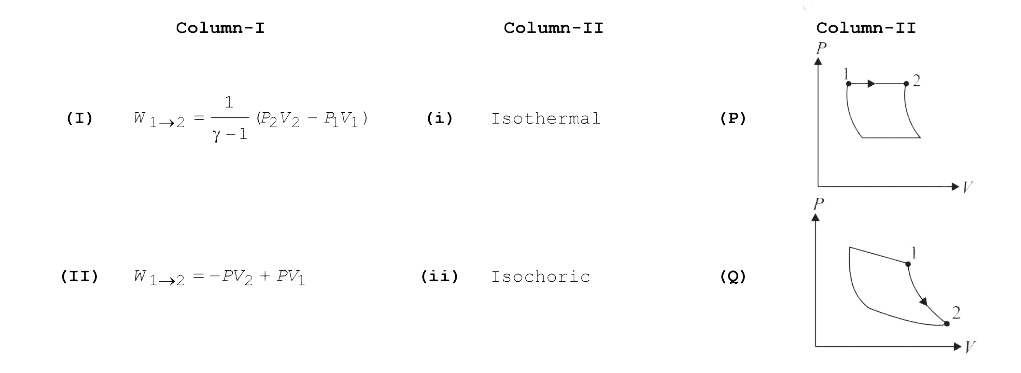A flat plate is moving normal to its plane through a gas under the action of a constant force F. The gas is kept at a very low pressure. The speed of the plate v is much less than the average speed u of the gas molecules. Which of the following options is/are true ?
The pressure difference between the leading and trailing faces of the plate is proportional to
The plate will continue to move with constant non-zero acceleration, at all times
At a later time external force F balances the resistive force
At a later time external force F balances the resistive force
The correct Answer is:A, C, D
To solve the problem, we need to analyze the motion of a flat plate moving through a gas at low pressure, under the influence of a constant force F. The speed of the plate v is much less than the average speed u of the gas molecules. We will examine the implications of this scenario step-by-step.
1. Understanding the System:
- A flat plate is moving through a gas. The gas is at very low pressure, meaning the density of gas molecules is low.
- The plate experiences a constant force F and moves with speed v, which is much smaller than the average speed u of the gas molecules.
2. Pressure Difference:
- As the plate moves, it interacts with gas molecules. The leading face of the plate will experience a higher pressure due to the incoming gas molecules, while the trailing face will experience a lower pressure as the gas molecules move away.
- The pressure difference ΔP between the leading and trailing faces of the plate can be expressed in terms of the average speed of the gas molecules u and the speed of the plate v.
- From kinetic theory, the pressure difference is proportional to the product of the average speed of the gas molecules and the speed of the plate:
ΔP∝u⋅v
3. Resistive Force:
- The resistive force Fr acting on the plate due to the gas molecules can be derived from the pressure difference:
Fr=ΔP⋅A
- Substituting the expression for ΔP:
Fr∝A⋅(u⋅v)
- This indicates that the resistive force is proportional to the product of the average speed of the gas molecules and the speed of the plate.
4. Constant Acceleration:
- Initially, the plate may accelerate due to the net force acting on it. However, as it continues to move, the resistive force will increase until it balances the applied force F.
- At some later time, the external force F will balance the resistive force Fr, leading to constant velocity (zero acceleration).
5. Conclusion:
- The pressure difference between the leading and trailing faces of the plate is proportional to u⋅v.
- At a later time, the external force F will balance the resistive force, resulting in no net acceleration.
Final Statements:
- The correct options based on the analysis are:
- The pressure difference between the leading and trailing faces of the plate is proportional to u⋅v.
- At a later time, the external force F balances the resistive force.
- A flat plate is moving through a gas. The gas is at very low pressure, meaning the density of gas molecules is low.
- The plate experiences a constant force F and moves with speed v, which is much smaller than the average speed u of the gas molecules.
- As the plate moves, it interacts with gas molecules. The leading face of the plate will experience a higher pressure due to the incoming gas molecules, while the trailing face will experience a lower pressure as the gas molecules move away.
- The pressure difference ΔP between the leading and trailing faces of the plate can be expressed in terms of the average speed of the gas molecules u and the speed of the plate v.
- From kinetic theory, the pressure difference is proportional to the product of the average speed of the gas molecules and the speed of the plate:
ΔP∝u⋅v
- The resistive force Fr acting on the plate due to the gas molecules can be derived from the pressure difference:
Fr=ΔP⋅A
- Substituting the expression for ΔP:
Fr∝A⋅(u⋅v)
- This indicates that the resistive force is proportional to the product of the average speed of the gas molecules and the speed of the plate.
- Initially, the plate may accelerate due to the net force acting on it. However, as it continues to move, the resistive force will increase until it balances the applied force F.
- At some later time, the external force F will balance the resistive force Fr, leading to constant velocity (zero acceleration).
- The pressure difference between the leading and trailing faces of the plate is proportional to u⋅v.
- At a later time, the external force F will balance the resistive force, resulting in no net acceleration.
- The correct options based on the analysis are:
- The pressure difference between the leading and trailing faces of the plate is proportional to u⋅v.
- At a later time, the external force F balances the resistive force.
Topper's Solved these Questions
- GASEOUS STATE & THERMODYNAMICSBOOK - VMC MODULES ENGLISHCHAPTER - GASEOUS STATE & THERMODYNAMICSEXERCISE - JEE MAIN (ARCHIVE )
81 Videos
- ENERGY & MOMENTUMBOOK - VMC MODULES ENGLISHCHAPTER - ENERGY & MOMENTUMEXERCISE - JEE ADVANCE (ARCHIVE) - TRUE/FALSE TYPE
1 Videos
- GRAVITATIONBOOK - VMC MODULES ENGLISHCHAPTER - GRAVITATIONEXERCISE - JEE Advance (Archive) TRUE/FALSE
1 Videos
Similar Questions
The temperature at which the average speed of perfect gas molecules is double than at 17∘C is
View SolutionThe temperature at which the average speed of perfect gas molecules is double than at 17∘C is
View SolutionWhich of the following processes would lead to an increase in the average speed of the molecules of an ideal gas system?
View SolutionA particle of mass M moves with constant speed along a circular path of radius r under the action of a force F. Its speed is
View SolutionThe r.m.s speed of the molecules of an ideal gas Is V0 If pressure of the gas is halved but temperature is kept constant then r.m.s. speed of the gas molecule will be
View SolutionConsider a thin square plate floating on a viscous liquid in a large tank. The height h of the liquid in the tank is much less than the width of the tank. The floating plate is pulled horizontally with a constant velocity u0. Which of the following statement is (are) true ?
View SolutionA broad metal plane is connected to earth through a conducting wire as shown. An electron flies with constant velocity along a straight line above the plate at a distance much less than the linear dimensions of the plate. If the current I flowing from the earth to the plate is considered to be positive, then which of the following graph correctly depicts the variation of current I with time ?

View SolutionA curved road is banked for speed v0. When a car moves along the road with a constant speed v, the force the friction between the road and the tyres is F. Which of the following statements(s) is (are) correct ?
View SolutionAn ideal gas is undergoing a cyclic thermodynamic process in different ways as shown in the corresponding P-V diagrams in column 3 of the table. Consider only the path from state 1 to state 2. W denotes the corresponding work done on the system. The equations and plots in the table have standard notations as used in thermodynamic process. Here is the ratio of heat capacities at constant pressure and constant volume. The number of moles in the gas in n.


Which of the following options is the only correct representation of a process in which ΔU=ΔQ−PΔV?
View SolutionThe potential energy of a particle of mass ? at a distance ? from a fixed point ? is given by V(r)=kr2/2, where ? is a positive constant of appropriate dimensions. This particle is moving in a circular orbit of radius ? about the point ?. If ? is the speed of the particle and ? is the magnitude of its angular momentum about ?, which of the following statements is (are) true?
View Solution
